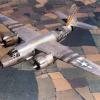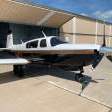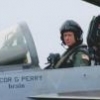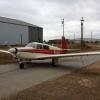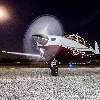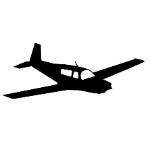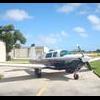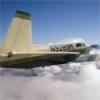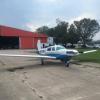Leaderboard
Popular Content
Showing content with the highest reputation on 02/05/2016 in all areas
-
It's taken me more than a year with delays, vacations and weather, but I finally passed my checkride this afternoon! As I understand it, now starts the real learning.8 points
-
Several months ago I lost my engine on takeoff at around 200ft and 120mph. I wasn't going to post anything about it, but I'm posting at the behest of others who thought that sharing my experience might save somebody's life. Here is what happened and what I did. The end result is that nobody was injured and the airplane was undamaged. The cause was FOD entering the #4 cylinder and destroying both spark plugs on initial climb out. The FOD was never found. I have an advanced graphic engine monitor and there was absolutely no indication of an imminent or pending failure. I fly between 150 and 250 hours/yr. I keep close tabs on the maintenance of my airplane, the only people that I allow to touch it are highly reputable and competent. And I'm saying this because I make a significant effort to eliminate myself from the groups and behaviors that make up accident statistics. I don't care who maintains your airplane, how many hours are on your engine or if it's brand new, this is something that can happen to you too. It was a hot day back in June; outside air temperature was above 90. Field elevation was a few hundred feet, winds were 9G16 with the windsock dancing perpendicular to the runway. I was close to max gross with two souls on board, full fuel and baggage. I was given an intersection departure on an 11,000ft runway. I declined the intersection departure and spent several minutes in my long taxi to the end of the runway. On takeoff, I accelerated down the runway with the intention of reaching Vy while in ground effect because of the shifty winds, hot temperature and weight of the airplane. Within seconds of pitching up, my engine because noticeably quiet, as if the mixture was out. I look down, verify the handles are all full-forward, look over the cowling and see what looks like maybe 2000ft of runway remaining with a field at the end. There are powerlines and a neighborhood at the end of the field. I was given a sage piece of advice by another pilot in the past: "Remember that when the engine stops making power, the airplane no longer belongs to you. It belongs to the insurance company." I did not hesitate to pull the throttle to idle, stood on the right rudder, dropped the gear, pumped in full flaps, slowed down and then dropped down towards the field with the rudder still at full deflection, pulling back on the yoke to add as much drag as possible. I frequently operate out of short fields with obstacles and I've found when fast and high that getting rid of airspeed before altitude shortens landing distance. Tower calls me, "Is everything ok?" "I've lost my engine." The field was a terraced down-sloping run-off field covered in weeds about four feet high. I forced the plane down fast, I'm guessing between 80 and 90 mph, on the mains because I knew that otherwise I would not be able to stop in time. The plane plowed through the weeds becoming airborne multiple times while barreling down the terraced field. I had full control authority. I had dropped the gear to add drag; it ended up being the right decision not only because it saved the aircraft, but it meant that my control surfaces remained undamaged and I was able to continue flying the airplane. I went from 120mph and 200ft to stopped in less than 4000ft. I stopped about 30 yards short of the neighborhood. In seeing it approach I was preparing to dig a wing into the ground if I had to. The only thought that wasn't related to flying that I had, while plowing through the tall grass, was "shit; is this it?" Upon stopping, I notice I still have the mic keyed. I tell the tower that "we're ok." They tell us emergency services are on their way. I started to turn off switches, then realize that we just needed to get out of the airplane. I had forgotten to unlatch the door, but I don't think that I would've had time to do so. Upon recovery of the airplane, the engine ran like crap. It was backfiring and popping and the #4 cylinder was completely offline. It was nice at least knowing that there was something wrong with the airplane. The most important decision that saved my ass was declining the intersection departure, and I bet that ground controller that gave it to me appreciated it as well. That first decision made the second one, to land immediately, possible. Had the terrain beneath me been less hospitable or had the field gone on forever, I might have attempted to nurse the plane along. I had split second to accept the one viable option at the time and took it without attempting to further diagnose the issue. Because it was a controlled field, the FSDO was immediately involved. All of my pilot and aircraft records were scrutinized.8 points
-
2 points
-
After further review, and assuming the OP has a KCS55A HSI system that was commonly installed by the factory, it doesn't appear that the KI-525A HSI has ILS lockout. The pilot's guides specify setting the OBS to the inbound course for ILS approaches. It also calls out for setting the front course inbound course when performing a back course in order to get proper needle sensing. So, the behavior of his HSI is normal, just not what he's used to seeing. Like I said before, the offset can be adjusted so the autopilot tracks on course easily enough, assuming everything is functioning properly otherwise.2 points
-
I noticed some grease in the right wheel well, but it was just a smudge on my laptop screen. Beautiful airplane.2 points
-
http://www.nbcnews.com/nightly-news/video/inside-la-s-massive-methane-gas-leak-616416323640 Bravo modified to sniff gas leaks.2 points
-
Personally I like the idea of buying an airplane with an engine in need of overhaul if the price is right. The new owner can convert the engine to an A3B6 with roller tappets and also have the comfort of knowing exactly how it has been operated. That's what I did with mine and I have no regrets.2 points
-
Some of the crew from AOPA is planning on flying into KMQS on Saturday 6 Feb. 2016 Weather is supposed to be nice. I'll be there with my M20S. If any other Mooney drivers want to come out for breakfast, I'd be great to see you there. Plan is to land around 0900 and get Breakfast at the Flying Machine Cafe http://www.chestercountyairport.com/1 point
-
Look through your logs and see how many hours are on them since they were new. Then see if they are oversized or std. Also determine if they are chrome or steel. How many hrs on the motor since overhaul? What is the general condition of the rest of the engine? Assuming the engine has somewhere in the 1000hr range then repairing the cylinders should last you as long as the rest of the engine.1 point
-
1 point
-
Fantastic! Great job! This things don't usually turn out that well. We are all proud of you!1 point
-
Yes, forward slip holding altitude to slow down, then once airspeed got under control I held the slip into the descent.1 point
-
Yes. I had it annualed and have put about 50 hours on it since then. I haven't heard from the FSDO for several months.1 point
-
It's a smelly, awkward, unpleasant, labor-intensive job. I was quite happy to find someone who chose this as a way to earn his living, with 15 years experience doing it. My arms are too short, my hands are too big, and I'm missing a couple of arm joints (especially the one I need 6" above my wrist to get the oil filter off of the Honda). Edison is great!1 point
-
Eddie sealed my tanks 3 years ago. The right wing has started leaking under the non-skid at the entry of the cabin (where one walks). Eddie has agreed to fix it under warranty as soon as I can get it down there. He has been very responsive. One piece of advice: A few months after the reseal, the aux tanks started leaking around the drains, and I had to fly down there to have him put in new drains (not under warranty). If you are going to go all the way down there, just have everything done and take no shortcuts.1 point
-
Hope they are not runny. I understand the liquid is bad for tablets. Sorry1 point
-
The gentleman from the great State of Delaware, please read more carefully. Nowhere did I suggest or even mention HDG mode. The op has clearly stated he has a King HSI. Not a plain heading indicator, a.k.a. DG. Therefore I suggested he center the course pointer on his HSI on the lubber line. Had he said he has a DG I would have suggested to center his heading. The purpose of my suggestion is to see if the ap tracks vloc with a centered course needle and hopefully shed some light into what the TC wants to do. It really has nothing to do with HDG mode. As I said, based on what he has described, I bet an adjustment needs to be made.1 point
-
I have the wind lace along with a new door seal, haven't put them on yet cause I was in & out along air hoses and electrical cords a million times and didn't want it to get damaged1 point
-
1 point
-
Proof that crummy distractions happen to young guys as well... Best regards, -a-1 point
-
Entry mistakes are not uncommon, I found a few old ones in my logbooks, like wrong filter ID on an oil change, etc.. Sloppy work to get paperwork done at the last minute... The best mechanics, treat the logbook as part of the maintenance process not as an afterthought. if it does have an engine that is not approved, that would be great leverage on the purchase to put a nice legal engine on it. If it is not legal, the seller doesn't have any leverage or legality to sell an "airworthy airplane" because it is not airworthy. Tough situation for the seller, which he will have to deal with any purchaser... if if it is just bookkeeping, then it can just be corrected with an entry by an IA, hopefully it is just a clerical error.1 point
-
1 point
-
Allow me to take a crack at this one. So, you appear to have two separate issues going on here. One is that when your CDI needle is centered, your autopilot is right of the intended course. This is a simple adjustment to the S-tec that any competent S-tec dealer should be able to make. The other issue is that when you're tuned to an ILS frequency the CDI needle centers to whatever heading you set the OBS to. Your HSI does not have "ILS lockout" enabled, could be an issue with the HSI, the 530, or the wiring in between. So, if your flying an ILS approach to runway 070, you need to set the OBS to 070 (or whatever the approach plate says) in order for your CDI needle to center on course. If ILS lockout was present, it wouldn't matter what the OBS was set to, the needle would center on the ILS course when a LOC frequency was driving it. Not all HSI's have this feature, but I am guessing your's should.1 point
-
Nice ride. A Bravo with an Aspen Evolution 2500 in the panel. What a cross country machine this setup would make! Sent from my iPhone using Tapatalk1 point
-
Congratulations - passing the IFR checkride felt better than getting my private.1 point
-
What does the L-I-F-T stand for in your checklist? Eagle eye! It is the mnemonic I used just as I am getting on the runway. L = Lights I = Instruments (HSI matches runway, altitude pre-select set, Nav set) F = Fuel (fullest tank, fuel pump on), Flaps T = Trim, Transponder, Time Off Sent from my iPad using Tapatalk1 point
-
I went with the less expensive, but works great route. I had a NavWorx 600-B installed for ADS-B out. It also transmits via wifi to my Ipad weather & traffic. I switched from Foreflight to XWingPro because FF doesn't play with others. The traffic on Xwing is great however, as it shows direction, altitude, speed, climbing or decending, and N# if ADS-B out aircraft. Turn key was $4K.1 point
-
1 point
-
In most cases, a factory spec Mooney tow bar will not interfere with a spinning prop.1 point
-
Some thoughts from a Bravo owner (that moved up from a J in December, 2013): Pro's: The long body of a Bravo adds a lot of baggage area. Combine that with the fold down rear seats and you probably have enough volume (not useful load) for 2 of Maruader's girls Long body is a bit more stable in turbulence I think the long body is easier to consistently produce better landings in Bravo's up until approximately 2000 models have room for 3 rows of instruments - you can fit a lot of instruments/avionics in that panel. Caveat is a shorter windshield. All Bravo's have built in o2 with 115 cubic foot bottles. 2 people can go from CA to NY and most of the way back on one fill at 18,000' Bravo is a production airplane - some people prefer that over a heavily STC'ed plane. I don't really care either way but it may make a difference at resale. Bravo's have a Lycoming engine (ok, flame suit on....) <<I think>> more Bravo's make it to TBO than Continental equipped planes. This may be due to the "wet head" design. DO NOT fly your bravo by the POH numbers or you will be replacing cylinders, exhaust and turbochargers on a very regular basis! Bravo's have 2 80-amp alternators and 2 batteries. The also have both a mechanical and backup electric vacuum pumps. A lot of redundancy is nice - especially if flying IFR You can put 106 gallon's of fuel in the Bravo, 100 of which is useable. It can have pretty long legs if you fly in an economy mode. My wife and I can depart with 106 gallons and pretty much all the baggage we want and still be with W&B limits. Note: if you fill extended fuel tanks in any Mooney model you will not get 2 medium sized people plus baggage in the plane and be within W&B limits. But also remember that the human bladder is much smaller than extended range tanks . My plane specific My engine is fairly easy to keep the temps under control My plane trues out at 210 KTAS @ FL210 on 18.5 GPH. This is excellent performance. I have a useful load of ~1015 lbs. Bravo Cons: Fuel burn: 16.5 - 18.5 GPH - better than a rocket, not as good as a 252 Engine replacement costs - YIKES Bravo: http://www.airpowerinc.com/productcart/pc/engines.asp?searchParm=tio540af1b&catID=33 Rocket: http://www.airpowerinc.com/productcart/pc/TCEngineDetail.asp?catID=69&prodID=25112 252: http://www.airpowerinc.com/productcart/pc/TCEngineDetail.asp?catID=69&prodID=24863 Bravo engine doesn't run LOP (except Awful_Charlie's plane) Bravo engine's typically don't run as smooth as the Continentals. I think the Bravo is an excellent plane and I am really glad I went with it. I don't have any time in either of the other models you listed so I really can't offer an opinion on them. Let me know if I can provide any additional information. Well, I guess that's all I have to say so best of luck! Dave1 point
-
I would certainly factor the cost of an overhaul into the asking price (same for the prop), but I would not be looking for a new engine until the current engine lets me know it's time for a change. Compressions are good, oil consumption is good, oil analysis good, engine runs strong? Until one of the above turns bad I would continue flying it. How long since last overhaul?1 point
-
For anyone interested I now have the installation manual for the vacuum powered speed brakes from Precise Flight. I offered to pay but they wouldn't accept. If interested just send me a message with your email. It's a nearly 3 meg file.1 point
-
Sounds like you only have the Mode S TIS traffic that is only available in major metro areas. I have the same via my GTX 330 ES and GNS 530W for a display. When I fly out of coverage, in annunciates "traffic unavailable" via voice and on the screen. It works well in terminal areas, but not out in the rural areas.1 point
-
FWIW Edison was honest, cooperative, and easy to work with. The current plane owner reports no issues a few years post-reseal. I'd go back there without hesitation. Sent from my iPad using Tapatalk1 point
-
On last factoid to put in the bladder camp. While looking for my airplane I talked to Joe Cole of Dalton Ga. According to him the bladders are permanent. That is, if they start leaking they can be refurbished in situ to new conditions with minimal input. He said the repair was roughly 1 AMU. Not trying to convince the OP of anything, but something that belongs in this discussion.1 point
-
Hahahah... yeah never mind a parachute, my wife wants our next airplane to have cupholders.1 point
-
1 point
-
How do the Avidyne units compare to the Garmin GTN 650/750? I know the difference in pricing and instal, just wondering about features and most importantly, user interface. The 430/530 is a user interface disaster IMO.1 point
-
Get a Dynon D1 or D2. Keep your vacuum unit. Done for under $2k and you have not just an electric gyro, which still has a relatively high failure rate, but a solid-state AHRS with no spinning parts. Not certified, but probably safer than a certified electric gyro AI at less than half the cost.1 point



